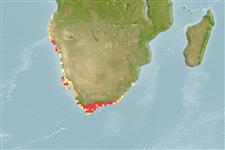>
Centrarchiformes (Basses) >
Cheilodactylidae (Morwongs)
Etymology: Cheilodactylus: Greek, cheilos = lip + Greek, daktylos = finger (Ref. 45335); referring to the fleshy lips and the lower, unbranched pectoral-fin rays (Ref. 120445).
More on author: Lacepède.
Environment: milieu / climate zone / depth range / distribution range
Ökologie
seewasser; brackwasser demersal; tiefenbereich 1 - 120 m (Ref. 120445). Subtropical
Southeast Atlantic: Namibia to Natal, South Africa.
Size / Gewicht / Alter
Maturity: Lm ? range ? - ? cm
Max length : 30.0 cm TL Männchen/unbestimmt; (Ref. 9492); common length : 20.0 cm TL Männchen/unbestimmt; (Ref. 9492)
Kurzbeschreibung
Bestimmungsschlüssel | Morphologie | Morphometrie
Rückenflossenstacheln (insgesamt) : 17 - 19; Rückenflossenweichstrahlen (insgesamt) : 23 - 25; Afterflossenstacheln: 3; Afterflossenweichstrahlen: 9 - 11.
Mainly in shallow water among rocks, but sometimes caught down to 120 m depth. Feeds on small crabs, mollusks, worms, and other small invertebrates (Ref. 9492). Tidepools apparently an important nursery habitat for juveniles (Ref. 120445),
Life cycle and mating behavior
Maturities | Fortpflanzung | Spawnings | Egg(s) | Fecundities | Larven
Smith, M.M., 1986. Cheilodactylidae. p. 667-668. In M.M. Smith and P.C. Heemstra (eds.) Smiths' sea fishes. Springer-Verlag, Berlin. (Ref. 5319)
IUCN Rote Liste Status (Ref. 130435)
Bedrohung für Menschen
Harmless
Nutzung durch Menschen
Fischereien: kleinfischerei
Tools
Zusatzinformationen
Download XML
Internet Quellen
Estimates based on models
Preferred temperature (Ref.
123201): 14 - 25, mean 18.2 °C (based on 74 cells).
Phylogenetic diversity index (Ref.
82804): PD
50 = 0.5000 [Uniqueness, from 0.5 = low to 2.0 = high].
Bayesian length-weight: a=0.01072 (0.00482 - 0.02382), b=3.06 (2.86 - 3.26), in cm total length, based on LWR estimates for this (Sub)family-body shape (Ref.
93245).
Trophic level (Ref.
69278): 3.4 ±0.46 se; based on food items.
Fishing Vulnerability (Ref.
59153): Low vulnerability (20 of 100).
Nutrients (Ref.
124155): Calcium = 94 [56, 171] mg/100g; Iron = 1.06 [0.72, 1.67] mg/100g; Protein = 19.2 [17.5, 20.9] %; Omega3 = 0.417 [0.286, 0.605] g/100g; Selenium = 23.8 [13.5, 40.5] μg/100g; VitaminA = 15.3 [6.8, 34.4] μg/100g; Zinc = 1.01 [0.76, 1.35] mg/100g (wet weight);
